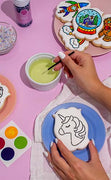
How to Avoid Color Bleed
Picture it: dozens of freshly-flooded soccer ball cookies drying on the counter, meticulously piped with carpal-tunnel-inducing black and white sections. Gorgeous, right?
Ok, now picture it 12 hours later, when those crisp black and white sections are now crisp black sections, and white sections that suddenly have a whole lot of grey happening at their borders. Now that cookier has carpal tunnel AND fuzzy soccer balls, to boot. THE WORST!
This, my friends, is the devastation that is color bleed. Let’s have a moment of silence for that poor cookier…

"Noooo, God! No, God, please no! No. No! Noooooooooooo!!!!" --Michael Scott finding out Toby is back, and Me waking up to color bleed
Ok, now let’s talk about how to avoid falling into this same devastation. Nine out of ten cookiers admit to dealing with color bleed at some point or another, and that tenth cookier is a dang liar, so they can’t be trusted (statistics may or may not be completely fabricated, but still sound right). The good news is that, since color bleed is such a widespread issue, there are lots of tips and tricks for how to mitigate the possibility of color bleed. The not-so-good news is that there is nothing you can do to 100% guarantee you won’t run into it, but it’s still worth a shot!
Color Corrections for Color Bleed
Start with a base icing that has white gel added to it. Uncolored royal icing has an off-white natural tinge and is more likely to allow bleed and absorb color. Add white gel to your base to act as a stabilizer to prevent color bleed right off the bat.
The biggest culprit in color bleed is usually oversaturated color. If you know you need a dark color icing, your best bet is to make it a day or two ahead so that you can use as little food coloring as possible and let it sit and develop, checking in on the progress and giving a stir every now and then. Get in the habit of making your icing the day before you need it, and color everything then so that it will all have time to develop. If the color you’re struggling most with is black (which is pretty typical), aim for a dark grey instead of true black.

Consistency & Color Bleed
Another tactic to prevent color bleed is to use a medium consistency flood instead of a really loose flood with a lot of water in it. Again, we are looking for stability, and the thicker flood can help each color mind its own business.
Piping & Color Bleed
Pipe full borders in each adjacent section, and let them dry a bit before adding the flood to prevent color bleed.
Use the same consistency in each color. Mismatched consistencies react differently to each other, so this starts them off on the same level and lowers your chances of color bleed.
Flood dark sections first and allow them to dry for a while before flooding lighter sections. Dried sections want to absorb moisture from freshly-flooded sections, so dried white will suck up black color, but dried black sections absorbing white color are harder to see and are less problematic. (This method obviously isn’t always possible, depending on the design, of course—especially if you have to add dark color on top of a light color, instead of next to it).
If you do have to flood a light section first, don’t allow it to dry completely before adding the dark neighbor. Again, you don’t want your dry lighter color to start to leech color from the fresh dark section.

When in Doubt
Make royal icing transfers ahead, or use edible marker or paints.
Again, unfortunately there’s no guaranteed way to avoid color bleed, but hopefully making a combination of small tweaks to your process can help make a difference.
Recommended for You:
Piping Bag Tip Tube Covers - Set of 4
AtecoDon't let your icing bags leak or dry out! Use these covers on bags with Ateco couplers and standard tips on them. Reuse them again and again. Se...
View full detailsBlack Fine Tip Food Marker
The Cookie CountessA black edible-ink pen is essential for your decorating kit. Use these high quality markers for: Marking up baked cookies for planning designs Wr...
View full detailsStainless Steel Measuring Cups 4 Piece Set
The Cookie CountessIncredibly high quality, with no plastic parts. Whether baking or cooking you'll reach for these essentials again and again! THESE ARE THE LAST SET...
View full detailsInstant Royal Icing Mix - White Base
The Cookie CountessJust add water for white, stiff icing! Perfect for stenciling, dots and eyes, writing, or thin it for flooding. You can tint it any color you need...
View full detailsCookie Order Form 5 x 7, 50 sheets
The Cookie CountessThese cute sheets will help you plan your cookie orders. The back has an area for sketching and pricing planning. Size: 5" x 7" 50 Sheet Pad Doub...
View full details-

Easter Cookie Orders Next Week? Here’s How to Prep Now (And Save Your Sanity)
Read nowEaster is just around the corner — and if you’re a cookier, that probably means your kitchen is about to look like a pastel explosion. Between custom orders, pop-up sales, PYO cookies, and all those cute little bunny minis… Easter...
-

Decorating a Vintage Heart Cake Cookie
Read nowYou've probably noticed that vintage heart cakes are having a MOMENT. It seems like everywhere you look, you'll see adorable heart cakes with fluffy borders, ruffles and swooshes and bows and cherries. The more ornate, the better. What's old is...
-

How To Make Cookie Moss!
Read nowAfter posting my recent blog about how to make ribbon bows, I had lots of questions about how I made the moss bunny. And I am at your service! So here are step by step instructions on how to make...


















Comments
Leave a comment